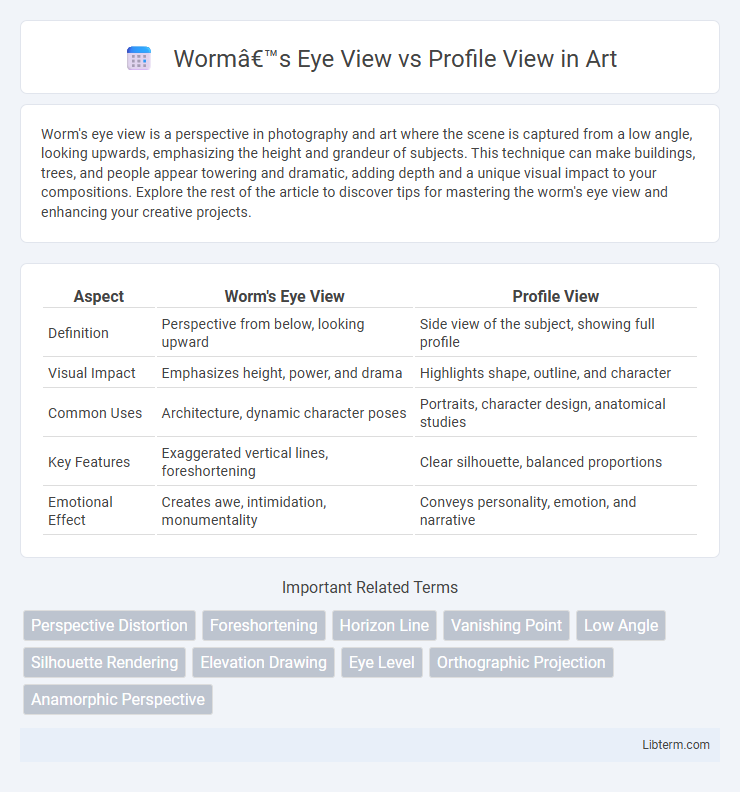Worm's eye view is a perspective in photography and art where the scene is captured from a low angle, looking upwards, emphasizing the height and grandeur of subjects. This technique can make buildings, trees, and people appear towering and dramatic, adding depth and a unique visual impact to your compositions. Explore the rest of the article to discover tips for mastering the worm's eye view and enhancing your creative projects.
Table of Comparison
| Aspect | Worm's Eye View | Profile View |
|---|---|---|
| Definition | Perspective from below, looking upward | Side view of the subject, showing full profile |
| Visual Impact | Emphasizes height, power, and drama | Highlights shape, outline, and character |
| Common Uses | Architecture, dynamic character poses | Portraits, character design, anatomical studies |
| Key Features | Exaggerated vertical lines, foreshortening | Clear silhouette, balanced proportions |
| Emotional Effect | Creates awe, intimidation, monumentality | Conveys personality, emotion, and narrative |
Introduction to Camera Angles
Worm's eye view captures subjects from an extremely low angle, emphasizing height and power by looking upward, often making objects appear dominant and dramatic. Profile view presents subjects from a side perspective, highlighting contours and movements without distortion, commonly used to convey realism and character detail. Both camera angles serve distinct visual purposes in storytelling, manipulating audience perception through unique spatial relationships.
Defining Worm’s Eye View
Worm's Eye View is a photographic or artistic perspective captured from a low vantage point looking upward, emphasizing height and scale. This angle accentuates the dominance or grandeur of subjects, often making objects appear towering and imposing. In contrast, Profile View presents a side perspective of a subject, highlighting contours and details without the dramatic vertical emphasis of the Worm's Eye View.
Understanding Profile View
Profile view offers a side perspective that highlights the subject's contours and depth, making it ideal for capturing facial features and body posture in detail. This angle enhances the dimensionality of objects or people, providing a clear outline and emphasizing height and length. Understanding profile view is essential for artists and photographers aiming to depict accurate proportions and dynamic poses.
Visual Impact: Worm’s Eye vs Profile
Worm's Eye View dramatically emphasizes height and scale, creating a sense of awe by looking up from a low angle, which visually distorts proportions to highlight verticality. Profile View provides a balanced and straightforward perspective, showcasing the subject's side without distortion, creating a clear and familiar representation. The visual impact of Worm's Eye View is more dynamic and immersive, while Profile View offers clarity and relatability.
Composition Techniques Compared
Worm's eye view emphasizes verticality and scale by positioning the camera low and angled upwards, creating a dramatic sense of height and power, while profile view captures the subject from the side, highlighting shape, movement, and interaction with the environment. Composition techniques for worm's eye view utilize strong converging lines and exaggerated perspectives to draw the viewer's eye upward, enhancing depth and grandeur. Profile view relies on balanced framing and negative space to showcase the subject's silhouette and gestures, often used to convey narrative or action through clear outlines.
Emotional Effects on the Viewer
A worm's eye view amplifies feelings of awe and vulnerability by placing the viewer in a low, upward-looking perspective that emphasizes size and dominance, often making subjects appear powerful or intimidating. In contrast, a profile view presents a neutral, observational angle that fosters emotional distance while highlighting character traits and expressions without overwhelming the viewer. The worm's eye view evokes strong emotional engagement through dramatic scale, whereas the profile view supports a more introspective and analytical response.
Usage in Photography and Art
Worm's Eye View emphasizes looking upward from a low angle, creating a sense of grandeur and dominance, often used in photography and art to accentuate scale and power in subjects like architecture and tall figures. Profile View captures the side outline of a subject, providing clarity of facial features and form, commonly employed in portraiture and character studies for its focus on distinct shapes and expressions. Both perspectives manipulate viewer perception, with Worm's Eye View enhancing drama and Profile View emphasizing structural detail and character.
Common Mistakes to Avoid
Worm's eye view often suffers from improper angle selection, leading to distorted proportions and loss of perspective accuracy, while profile view commonly faces errors in alignment and scale, causing stiff or unnatural character representation. Avoid inconsistent vanishing points in worm's eye view to maintain depth, and in profile view, ensure correct anatomical landmarks for realistic side angles. Misjudging these elements compromises visual clarity and undermines the intended dramatic or contextual impact.
Practical Tips for Each View
Worm's Eye View emphasizes looking upward from a low angle, ideal for showcasing towering structures or creating dramatic perspectives; use a wide-angle lens to exaggerate height and maintain stability with a tripod for sharp images. Profile View captures subjects from the side, effectively highlighting contours and motion, making it crucial to position lighting to enhance texture and employ a fast shutter speed for dynamic subjects. Both views benefit from thoughtful composition and subject placement to maximize visual impact and storytelling effectiveness.
Choosing the Right Perspective
Choosing the right perspective between worm's eye view and profile view depends on the intended impact and storytelling goal; a worm's eye view emphasizes scale and power by looking up from a low angle, making subjects appear dominant or monumental. Profile view offers clarity and detail of the subject's side, ideal for character identification, emotion, and motion analysis. Selecting the perspective enhances narrative meaning, visual interest, and audience engagement based on the mood, context, and spatial relationships.
Worm’s Eye View Infographic

 libterm.com
libterm.com